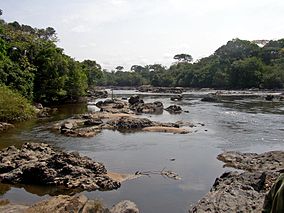- Okapi Wildlife Reserve
-
Okapi Wildlife Reserve IUCN Category II (National Park)
Epulu River in the Okapi Wildlife ReserveLocation Democratic Republic of the Congo Nearest city Isiro Coordinates 02°00′00″N 28°30′00″E / 2°N 28.5°ECoordinates: 02°00′00″N 28°30′00″E / 2°N 28.5°E Area 13,726.25 km2 (5,299.73 sq mi)[1] Established 1992[2] Governing body l'Institut Congolais pour la Conservation de la Nature (ICCN) Type: Natural Criteria: x Designated: 1996 (20th session) Reference #: 718 State Party: Democratic Republic of the Congo Region: Africa Endangered: 1997- The Okapi Wildlife Reserve is a World Heritage Site in the Ituri Forest in the north-east of the Democratic Republic of the Congo, near the borders with Sudan and Uganda. At approximately 14,000 km², it covers approximately one fifth of the area of the forest.
Contents
Location
The Nepoko, Ituri and Epulu rivers flow through the reserve. The imposing Mbiya Mountain overlooks the Epulu village. The reserve is home to about 5,000 okapi, 4,000 elephants, 2,000 leopards, chimpanzees and crocodiles. Other Ituri rain forest animals include forest buffalo, water chevrotain, and forest elephants. The reserve has over 300 species of bird, and is one of the most important sites for bird conservation in mainland Africa.[3] Nomadic Mbuti pygmies and indigenous Bantu farmers also live within the reserve.
History
The Okapi Wildlife Reserve was added to the list of world heritage sites in danger in 1997. The main threats to the reserve are deforestation, primarily caused by slash and burn agriculture, and commercial hunting for the sale of bush meat. Gold mining has also been problematic to the Reserve. As of 2005, the fighting in the eastern part of the country moved within the boundaries of the Reserve, causing its staff to flee or be evacuated. While the native Mbuti and Bantu peoples traditionally respect the forest and its wildlife, immigrants into the area do not feel the same connection to the land. Lack of funding due to the poor political and economic conditions of the Democratic Republic of the Congo has also been problematic. It is hoped that eco-tourism to the area can be developed, leading to both increased funding and improved public awareness.
Conservation
As implied by the name, the reserve is home to many okapis. As of 1996, the number was estimated at about 3900–6350, out of a global population of around 10,000–20,000. It is also the location of the Epulu Conservation and Research Center, on the Epulu River. This facility dates back to 1928 when the camp was founded by American anthropologist Patrick Putnam as a capture station, where wild okapis were captured and sent to American and European zoos. It still serves that function today, albeit with very different methodology. Okapis are captured, and then bred in captivity, and then only these offspring are sent to zoos, as it has been found that they have a much lower chance of survival. Even so, very few are now exported — only the minimum number necessary to ensure genetic viability of the captive population. The center also carries out much important research and conservation work.
See also
References
- ^ INSTITUT CONGOLAIS POUR LA CONSERVATION DE LA NATURE. Okapi
- ^ Okapi
- ^ "Okapi Wildlife Reserve". Guide for Africa. http://www.guideforafrica.com/congo-drc/okapi-wildlife-reserve.html. Retrieved 2011-10-25.
Further reading
- Susan Lyndaker Lindsey; Mary Neel Green; Cynthia L. Bennett (1999). The Okapi. University of Texas Press. ISBN 0-292-74707-1
External links
- Government website: l'Institut Congolais pour la Conservation de la Nature (ICCN)
- UNESCO Okapi Wildlife Reserve Site
- UNEP-WCMC world Heritage site datasheet
- Blogs from the Rangers of the Okapi Wildlife Reserve
- Gilman International Conservation
National Parks of the Democratic Republic of Congo World Heritage Sites in the Democratic Republic of the Congo Garamba National Park · Kahuzi-Biega National Park · Okapi Wildlife Reserve · Salonga National Park · Virunga National Park
Categories:- IUCN Category II
- World Heritage Sites in the Democratic Republic of the Congo
- National parks of the Democratic Republic of the Congo
- Protected areas established in 1992
- World Heritage in Danger
- Faunal reserves
Wikimedia Foundation. 2010.
